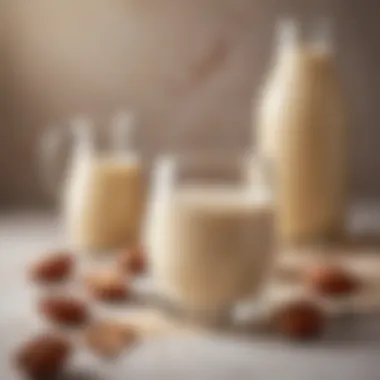The Mylk Maker: A New Era in Dairy Alternatives


Intro
In the quest for healthier, sustainable living, many consumers are turning toward plant-based alternatives. A significant innovation in this movement is the mylk maker, a device that simplifies the creation of homemade plant-based milk. This trend is not just about taste but also offers numerous benefits, such as ecological sustainability, dietary diversity, and nutritional advantages.
The mylk maker is more than just a kitchen gadget; it embodies a lifestyle choice. With the surge in popularity of veganism and lactose-free diets, these machines provide a convenient solution for making milks from a variety of ingredients, including almonds, oats, soy, and coconut. Understanding the functioning and advantages of mylk makers can enhance one’s culinary experience while fostering a deeper appreciation for plant-based living.
The mylk maker manages to cater to diverse dietary preferences. It does not only aid in the quick preparation of these alternatives, but it also allows customization according to individual taste and health requirements. This article aims to elucidate the myriad aspects of mylk makers, from their functionality and unique features to practical tips for usage. By the end, readers will gain an in-depth understanding of the mylk maker's role in revolutionizing dairy alternatives.
Prologue to Mylk Makers
The emergence of mylk makers represents a significant shift in how individuals consume dairy alternatives. This section aims to shed light on the importance of these appliances in the context of modern dietary preferences and sustainability. As consumers become increasingly aware of health implications and environmental concerns associated with traditional dairy, mylk makers offer a practical solution. They allow for the creation of plant-based milk from a multitude of sources such as nuts, grains, and seeds, catering to various dietary needs and preferences.
Definition and Purpose
Mylk makers are kitchen devices specifically designed to produce homemade plant-based milk. They typically consist of a blending unit that processes soaked ingredients with water, followed by a filtering mechanism to separate the liquid from the pulp. This results in fresh mylk that can be tailored to individual tastes and nutritional requirements. The purpose of mylk makers extends beyond convenience; they promote a shift towards more sustainable food practices. By producing milk alternatives at home, users reduce reliance on packaged products, minimize waste, and can select organic ingredients that align with their health goals.
Evolution of Dairy Alternatives
The landscape of dairy alternatives has evolved significantly over the last few decades. Initially, options like almond and soy milk were pioneers in the market. However, the recent surge in dietary restrictions and preferences, such as lactose intolerance and veganism, paved the way for a broader spectrum of alternatives. Nowadays, it includes options like cashew, oat, hemp, and coconut mylks. Moreover, the rise of the health-conscious consumer has bolstered the demand for products free of preservatives, added sugars, and synthetic ingredients.
Mylk makers reflect this evolution, serving not just as a tool for convenience, but as a means for empowerment in food choices. They embody the increasing desire for transparency in food production and enable users to experiment with flavors, textures, and nutritional profiles that meet their specific needs.
Understanding Mylk Makers
Mylk makers play a significant role in today's plant-based dietary landscape. They cater to the growing demand for dairy alternatives while providing users with the tools needed for home production. Their importance is not only in functional aspects but also in the sustainability and health considerations they bring along.
Types of Mylk Makers
Manual Mylk Makers
Manual mylk makers are sometimes favored for their simplicity and lower cost. They involve a more hands-on approach, requiring users to manually blend and strain ingredients. The key characteristic of a manual mylk maker is its no-frills design, making it accessible for a wide range of consumers. This choice can be beneficial, especially for those who are just entering the plant-based scene.
Unique features include portability and ease of storage, as these devices do not require a power outlet. However, the downside lies in the effort required to produce your mylk.
Electric Mylk Makers
Electric mylk makers automate the process, making it quick and hassle-free. This type is known for its efficiency in combining ingredients and filtering them at the same time. The convenience of switching it on and waiting for the mylk to be ready is appealing to many potential users.
A unique aspect of electric models is their ability to control the temperature during blending, which aids in releasing flavors and nutrients. However, these machines can be more expensive and may require specific care to maintain their functionality.
High-Speed Blenders
High-speed blenders are an alternative for those who already own one. This approach allows users to create mylk at a fast pace without the need for additional devices. Known for its versatile functionality, a high-speed blender can handle a variety of ingredients beyond just mylk.
The unique feature of high-speed blenders is their blending power, capable of producing a silky-smooth consistency. The downside is that they may require additional straining depending on the ingredients used, adding a step back into the process.
Key Features and Specifications
Capacity
Mylk makers vary in capacity, influencing how much plant-based mylk can be produced in one go. A proper assessment of capacity is essential for users, especially those with large households or regular consumption patterns. High-capacity models reduce the need for frequent refills, providing a convenient solution.
However, larger models can take up more space, which is a consideration for smaller kitchens.
Material Quality
Material quality is pivotal in ensuring safety and durability. Mylk makers are commonly made with materials like stainless steel, plastic, or glass. High-quality materials not only ensure longevity but also avoid potential chemical leaching into the beverage.
Models with stainless steel components tend to be favored for their robustness, though they may come with a higher price tag. It's essential to evaluate the materials to make an informed choice.
Ease of Cleaning
Cleaning is an often-overlooked aspect of mylk makers. A device that is easy to clean can enhance the overall user experience. Look for models with parts that are dishwasher-safe or feature smooth surfaces that are easy to wipe down.
Complex designs with many nooks and crannies can lead to challenges in cleaning. Thus, ease of cleaning significantly impacts the overall convenience and joy of using these devices.
The Benefits of Using a Mylk Maker
The functionality of a mylk maker extends beyond mere convenience in preparing plant-based milk. It supports a broader lifestyle shift that emphasizes health and environmental consciousness. As more consumers choose plant-based diets, understanding the benefits associated with mylk makers becomes critical. These devices simplify the process of creating dairy alternatives, ensuring fresh, tailored options that meet individual dietary needs.
Health Considerations
Nutritional Benefits
Nutritional benefits of plant-based milk produced by mylk makers are significant. Many plant-based milks retain essential vitamins and minerals while avoiding unhealthy additives. For example, almond mylk is rich in vitamin E, which can contribute to skin health. Other varieties, like oat mylk, offer higher fiber content, promoting better digestion. These options are not just alternatives to dairy; they can enhance one’s diet with natural nutrients.


The key characteristic of these nutritional benefits lies in the ability to control what goes into the mylk. By using whole, raw ingredients, consumers can avoid preservatives and additives commonly found in store-bought versions. This feature is crucial for those who prioritize health and want transparency in their food sources.
Allergy-Friendly Options
Allergy-friendly options are another vital consideration. Many people are lactose intolerant or allergic to common dairy ingredients. Mylk makers offer an array of choices, allowing users to create mylks that suit their specific allergies. For instance, coconut mylk is a great option for those avoiding nuts.
The flexibility in choosing base ingredients is a significant advantage. It enables consumers to experiment without fear of allergic reactions. Additionally, creating these alternatives at home ensures that they remain free from cross-contamination, promoting a safer experience for sensitive individuals.
Sustainability Aspects
Reduction of Packaging Waste
Reducing packaging waste is an essential aspect of sustainability. Traditional dairy products often come in non-recyclable plastics, contributing to environmental harm. With mylk makers, ingredients are usually purchased in bulk, minimizing the overall amount of packaging used. This choice aligns well with a sustainable living ethos.
The ability to create milk alternatives on demand also means there is less waste generated from spoilage. By producing only as needed, consumers can further reduce their environmental impact. This characteristic resonates with those committed to sustainable practices, adding to the appeal of mylk makers.
Local Sourcing of Ingredients
Local sourcing of ingredients enhances both quality and sustainability. Many users of mylk makers prioritize fresh, organic, and local produce. This emphasis not only supports local agriculture but also reduces carbon footprints associated with long-distance food transport. By selecting ingredients sourced from nearby farms, consumers can ensure freshness and flavor in their mylks.
Local sourcing is beneficial for building community relationships and promoting sustainable farming practices. Consumers who support local economy contribute to more resilient agricultural environments, which can adapt better to changes and promote biodiversity.
In summary, the benefits of using a mylk maker incorporate health considerations and sustainable practices. Consumers gain nutritional advantages and cater to specific dietary needs while also contributing positively to the environment. Therefore, investing in a mylk maker is aligned with both personal health goals and broader sustainability efforts.
Best Ingredients for Mylk Production
The choice of ingredients for making plant-based milk is critical for various reasons. First, different ingredients have unique flavors, textures, and nutritional profiles. Each option brings distinct characteristics, allowing users to explore a range of flavor potentials. Moreover, the health benefits associated with various ingredients can cater to specific dietary needs. As consumers become more mindful of what they eat, selecting the right ingredients can enhance not only the taste but also the overall quality of the mylk.
Common Plant-Based Ingredients
Almonds
Almonds serve as an excellent base ingredient for mylk production. They are known for their creamy texture and nutty flavor, making almond mylk a popular choice among consumers. Almonds are also low in calories but rich in essential nutrients such as vitamin E, magnesium, and healthy fats.
One unique feature of almonds is their versatility; they can be used to create various flavored milks simply by addings few extra ingredients like vanilla or cocoa. A potential disadvantage, however, is that some individuals may have nut allergies, which limits almond mylk's accessibility for those users.
Coconuts
Coconuts contribute a rich and tropical flavor to mylk. The key characteristic of coconut mylk is its thickness and creaminess, often preferred in recipes requiring rich taste. Coconut-based mylks offer the advantage of being easily digestible and are often praised for their medium-chain fatty acids, which may support energy levels.
However, one should consider that coconut mylk has a more pronounced flavor that may not suit all recipes. Additionally, its high-fat content can be a concern for those monitoring their fat intake, making it less appealing for some consumers.
Oats
Oats have gained popularity as a base for mylk due to their natural sweetness and smooth texture. They are considered beneficial because they are more affordable and easier to source than some other nuts or seeds. Oat mylk is often favored for its ability to froth well, making it an excellent choice for coffee-based drinks.
A unique feature of oats is their high soluble fiber content, offering the added health benefits of supporting heart health and digestion. Nevertheless, oat mylk can sometimes develop a slimy texture if not blended properly, which can be a disadvantage.
Enhancing Flavor and Nutritional Value
Enhancing the flavor and nutritional value of your mylk can significantly increase its appeal. Adding sweeteners and flavor additives is a common practice.
Sweeteners
Sweeteners play a crucial role in balancing flavors in mylk. Common options include agave syrup, maple syrup, and dates. The key characteristic of these sweeteners is their ability to enhance taste without overpowering the natural flavors of the base ingredients.
Including sweeteners can make the mylk more appealing, especially for children or those with a sweet tooth. However, one downside is the additional calories and sugar content, which can deter those who are looking for a healthier option.
Flavor Additives
Flavor additives such as vanilla extract, cocoa powder, or cinnamon can significantly transform the mylk experience. These additives elevate the taste profile, making the final product more enjoyable. The benefit of these additives lies in their capability to cater to diverse palates.
However, it is essential to choose flavor additives wisely, as some may contain artificial ingredients that contradict the concept of creating a wholesome beverage. This consideration is crucial for consumers who prioritize organic or minimal processing in their food.
How to Operate a Mylk Maker
Understanding how to operate a mylk maker is crucial for both new and seasoned users. This section unfolds the operational steps, allowing consumers to maximize the potential of their devices. Correct operation ensures high-quality mylk with desirable flavors and textures. Knowing the process can lead to the best results, minimize ingredients waste, and enhance user experience. Mylk makers streamline the art of crafting plant-based milk, making it essential for users to grasp the correct setup and execution methods.
Preparation of Ingredients
Before engaging with the mylk maker, preparation of ingredients is a significant step. Properly prepared ingredients lead to better taste and efficiency in the milk-making process. Start by selecting your base ingredient. Common choices include almonds, oats, and coconut. Each base has its unique property, affecting flavor and nutrient content.
Consider the following preparation guidelines:
- Soaking: If using nuts or seeds, such as almonds, soaking them overnight enhances their texture and makes blending smoother. This is also useful for digestion and absorption of nutrients.
- Washing: For grains like oats, rinsing helps remove any contaminants or dust, ensuring purity.
- Measuring: Ensure to measure ingredients accurately. A general guideline is one cup of base to three or four cups of water, but this can be adjusted based on desired thickness.
In addition, consider any additives like sweeteners or flavorings. Adjust according to personal preference. This simple yet effective preparation sets the stage for a successful mylk production.


Step-by-Step Mylk Making Process
Once the ingredients are prepared, the mylk making process becomes straightforward. Follow these steps to create your personalized plant-based milk:
- Assemble the Mylk Maker: Ensure the mylk maker's components are clean and properly assembled. Depending on the model, you may have different parts that need attachment.
- Add Ingredients: Place the prepared ingredients into the mylk maker's container. Add water as measured, remembering the ratio based on your preference.
- Select Settings: Depending on the device, select the appropriate settings for nut, grain, or seed mylk. Some machines offer specific options for different types of ingredients.
- Start the Machine: Power on the mylk maker and allow it to blend the contents. The duration can vary from one to five minutes depending on the maker’s capacity.
- Strain the Mylk (if needed): Some models can filter the mylk automatically, while others may require straining the mixture post-blending. Use a cheesecloth or fine mesh strainer for best results.
- Store or Serve: Transfer the mylk into a suitable container for storage. If consuming immediately, enjoy it fresh.
Following these steps will yield nutritious, homemade mylk, aligning with the increasing demand for dairy alternatives. Operating a mylk maker may appear simple, but attention to detail ensures exceptional results.
Mylk Variations and Recipes
Mylk variations are an essential aspect of the mylk maker experience. By diversifying the types of plant-based milks produced, users can cater to different taste preferences and nutritional needs. Each type of mylk offers unique flavors, textures, and health benefits. Recipes that utilize various base ingredients enhance creativity in the kitchen, making the process of creating dairy alternatives not just practical, but also enjoyable. This section delves into distinct types of mylk based on their base ingredients and presents popular recipes for enthusiasts.
Variations by Base Ingredient
Nut-Based Mylks
Nut-based mylks, such as almond or cashew, are popular choices among consumers seeking creamy textures and rich flavors. They come packed with healthy fats and protein, making them nourishing options. Almond mylk, for instance, is known for being lower in calories compared to dairy milk and often has a slightly sweet taste. The preparation of nut-based mylks typically involves soaking nuts prior to blending, which aids in texture and flavor extraction.
A key characteristic of nut-based mylks is their versatility in recipes. They can be used in smoothies, coffee, and baking, making them a well-rounded choice for the home cook. However, they might present drawbacks for those with nut allergies, thus it's crucial to always check for allergens before consumption.
Grain-Based Mylks
Grain-based mylks, like oat, are gaining traction due to their smooth texture and naturally sweet flavor profile. Oat mylk tends to have a creamier consistency, which many find appealing. It is often chosen for its fiber content, which contributes to its heart-health benefits. The ease of making oat mylk at home is another significant advantage; oats require minimal soaking and can blend quickly.
However, one unique feature of grain-based mylks is their higher carbohydrate content compared to other kinds, which may concern those on low-carb diets. Nevertheless, they are increasingly seen as a sustainable option since oats are widely cultivated and easily sourced.
Seed-Based Mylks
Seed-based mylks, such as hemp or flaxseed, have become alternatives for those looking for dairy-free options rich in Omega-3 fatty acids. They offer a distinct flavor and can provide additional health benefits. For instance, hemp mylk is particularly noted for its protein content and nutty taste, appealing to those seeking nutritional density without the use of nuts or grains.
The unique feature of seed-based mylks is their potential to target specific nutrition goals, such as enhancing heart health. However, they may not be as creamy as nut or grain mylks, which could deter some consumers. While diverse in taste profiles, these mylks contribute richly to the plant-based mylk landscape by filling nutritional gaps.
Popular Mylk Recipes
Almond Mylk
Almond mylk stands out for its delicate flavor and light consistency. The key characteristic here is the subtle sweetness that almond provides naturally, making it a favored option in smoothies and cereals. This mylk contributes well to the overall goal of offering a delicious plant-based alternative while also being dairy-free.
One unique feature of almond mylk is its adaptability; it can be adjusted easily by adding flavors like vanilla or cinnamon. However, it is important to note that some brands may add preservatives or sweeteners, which could undermine its all-natural appeal. Users can opt for homemade almond mylk to avoid unwanted additives, ensuring freshness and a cleaner consumption experience.
Oat Mylk
Oat mylk is recognized for its creamy texture, making it suitable for coffee drinks. It is a popular choice in many cafes. The rich flavor that oats provide pairs well with both sweet and savory dishes, contributing to its broad appeal. People often choose oat mylk for its sustainability, as oats have a lower environmental impact compared to other plant sources.
This mylk’s unique feature is its natural emulsion properties, which help in creating frothy textures ideal for lattes. However, some may find that oat mylk has higher carbohydrate content, which could be a drawback for certain dietary preferences.
Coconut Mylk
Coconut mylk is celebrated for its tropical flavor and thick texture. It is often used in culinary applications, such as curries or desserts. The distinctive feature of coconut mylk is the luscious creaminess it brings to food, elevating any dish with its unique flavoring. It also comes with the advantage of providing a range of vitamins and minerals.
On the flip side, coconut mylk can be higher in saturated fat compared to other plant-based options. This can raise concerns for some consumers regarding heart health. Nonetheless, its flavorful contribution makes it worthwhile for those who enjoy its taste and potential health benefits.
In summary, understanding the variations and recipes available with mylk makers enhances the ability to create tailored, delicious, plant-based dairy alternatives. Each type offers unique benefits, flavors, and uses that can satisfy diverse palates.
Maintaining Your Mylk Maker
The maintenance of your mylk maker is crucial for its longevity and optimal performance. Regular upkeep not only ensures that the machine operates efficiently but also enhances the quality of the mylk produced. Dirty components can affect taste and result in contamination. Thus, it is essential to follow proper maintenance procedures for a healthy experience.
Cleaning Guidelines
To maintain your mylk maker, cleaning it after each use is strongly recommended. Here are some essential practices:
- Disassemble Immediately: After use, disassemble the parts like the pitcher, lid, and filter. This prevents residue from drying and sticking.
- Use Warm Water: Rinse the components with warm water to remove scraps effectively. This is recommended over cold water, as it dissolves particles better.
- Gentle Soap: Apply mild dish soap to clean the surfaces. Avoid harsh chemicals which might damage the material.
- Avoid Scratches: Use a soft sponge. Scratch-resistant surfaces still require gentle handling to keep them intact.
- Dry Thoroughly: After cleaning, allow parts to air dry completely before reassembling. Moist environments can lead to mold growth.
"A clean mylk maker not only preserves flavor but also extends the device's lifespan."
Troubleshooting Common Issues
Even with regular maintenance, issues might arise. Here’s how to handle common problems:
- Mylk Consistency Issues: If the mylk comes out too gritty, check the filter or strainer for blockages. Ensure it is clean and free from residue.
- Strange Odors: Any persistent odor could indicate leftover ingredients. A thorough clean, especially in the pitcher, might solve this.
- Electrical Issues: If the device doesn't turn on, check the power source and cords for damage. If problems persist, consider consulting the user manual or manufacturer support.
- Overheating: If the machine overheats, give it a break. Continuous use can lead to malfunctions. Let it cool down before next operation.
Maintaining your mylk maker can enhance the enjoyment of home-made dairy alternatives while ensuring the device lasts longer. Proper cleaning and understanding common issues can make a significant difference.
Market Analysis of Mylk Makers
Understanding the current market dynamics surrounding mylk makers is crucial for both consumers and manufacturers. The rise in demand for plant-based products has fueled growth in this niche appliance market. Analyzing this sector provides insights into the consumer preferences, industry innovations, and potential challenges that brands may face. As more people shift towards dairy alternatives, brands must adapt to evolving trends, ensuring their products align with health, sustainability, and convenience.


Leading Brands and Their Offerings
Several brands dominate the mylk maker market, each with unique offerings tailored to different consumer needs. Notable brands include:
- NutraMilk: Known for its high-capacity electric mylk makers, NutraMilk focuses on versatility and ease of use. Their devices enable users to create various choices from nuts to seeds, making them appealing to health-conscious consumers.
- Almond Cow: This brand emphasizes simplicity and a minimalist approach. The Almond Cow mylk maker is designed for easy operation, requiring minimal parts to clean and assemble, appealing to a busy audience.
- OATLY: While primarily a brand offering oat milk, OATLY has ventured into the mylk maker space with products that complement their existing range. Their machines emphasize efficiency and quick production times, catering to a growing preference for oat-based options.
These brands not only provide superior quality products but also aim to educate consumers on the benefits of homemade mylks versus store-bought options. They focus on reliable customer feedback and innovative features to remain competitive.
Price Range and Value Assessment
When assessing the price range of mylk makers, consumers can expect to find a variety of options ranging from budget to premium models. Typically, prices may vary as follows:
- Budget models: Generally priced between $50 to $100. These usually are manual or basic electric models intended for casual users who may make mylk occasionally.
- Mid-range models: Ranging from $100 to $200, these offer advanced features like greater capacity and additional functionalities for making various types of mylks.
- Premium models: Often above $200, these electric mylk makers feature advanced technology, higher efficiency, and a broader range of options including self-cleaning mechanisms and app connectivity.
Considering the price relative to value is essential. Higher-priced models often boast better durability and technology integration, potentially offering more savings in the long run by reducing reliance on packaged mylks. Ultimately, the decision often boils down to individual usage patterns and the importance placed on convenience versus cost.
"Investing in a mylk maker can save money in the long run, especially for regular consumers of plant-based milk alternatives."
Consumer Perspectives on Mylk Makers
In the world of culinary appliances, the mylk maker has emerged as a significant player. Understanding consumer perspectives is crucial for evaluating its impact on the market and assessing user satisfaction. Consumers today are increasingly health-conscious and concerned with sustainability. The rise of mylk makers reflects this shift in preference towards plant-based diets and the demand for fresh, customizable alternatives to traditional dairy products.
Engagement with mylk makers extends beyond taste. Users are often interested in factors like convenience, nutritional benefits, and eco-friendliness. Not only do they seek to create delicious mylk at home, but they also desire transparency in ingredients and the overall process. As such, feedback from users provides valuable insights that potential buyers can utilize in making informed decisions.
User Experience and Feedback
User experience with mylk makers tends to be positive, with many praising the ease of use. Reviews often highlight factors such as intuitive design, quick preparation times, and cleanup processes. Consumers appreciate that they can skip store-bought mylk, which sometimes contains additives and preservatives. Many users mention the satisfaction of crafting their own mylk exactly how they like it, allowing for personalization in flavor and consistency.
Feedback also brings to light areas for improvement. Certain models may struggle with consistency, yielding overly watery or thick mylk. These insights prompt manufacturers to innovate and enhance their products.
"The freshness from making mylk at home is unmatched. I love that I can control what goes in it!" - A dedicated mylk maker user.
Trends in Consumer Preferences
Recent trends indicate a growing preference for plant-based diets, contributing to the expanding popularity of mylk makers. Health benefits often take center stage, as consumers become more aware of the advantages of plant-based alternatives. This shift in preferences reflects broader societal concerns about health, environment, and ethical consumption.
Some notable trends include:
- Ingredient Focus: Users seek mylk makers that accommodate a variety of bases such as oats, almonds, and cashews. The flexibility to try different ingredients has become a priority.
- Sustainable Choices: Environmentally aware consumers prefer mylk makers that prioritize sustainability in production and packaging.
- Innovative Features: High-speed blending, smart functionality, and ease of cleaning are increasingly demanded. Consumers now look for models that integrate technology while being user-friendly.
By understanding these consumer perspectives, manufacturers can tailor their products to meet market demands, ensuring they stay relevant in an evolving landscape. This evolving dialogue between consumer and manufacturer shapes the future of mylk makers, promising innovation and enhanced user experience.
The Future of Mylk Makers
The future of mylk makers holds significant promise for consumers and the broader food industry. As plant-based diets become increasingly popular, the demand for accessible, quality alternatives to dairy will grow. Mylk makers will play a pivotal role in this shift, offering individuals a way to manufacture their own milk substitutes with ease and efficiency. This section examines important innovations in technology and potential market segments that could shape this landscape.
Innovation in Technology
Technology is crucial to the evolution of mylk makers. Presently, many models already incorporate advanced features such as smart sensors and programmable settings. These innovations enable users to customize their plant-based milk according to taste and dietary needs. For instance, features such as temperature control can optimize nut soaking, enhancing flavor and nutrition.
Additionally, manufacturers are exploring options like self-cleaning mechanisms, making maintenance more manageable. As these devices become more sophisticated, usability will also increase. This trend toward user-friendly technology appeals to a wider audience, encouraging even those who are not experienced cooks to engage with these products.
The integration of applications for smartphones and tablets could provide users with guided recipes and nutritional tracking, further enhancing their experience. Overall, as technology continues to advance, mylk makers will likely become more versatile, appealing to both casual users and dedicated health enthusiasts.
Potential New Market Segments
The market for mylk makers is still in the process of developing. One anticipated segment is the commercial sector, including coffee shops and health-focused cafes. These businesses often offer a range of milk alternatives to cater to diverse customer preferences. Investing in mylk makers could allow them to create fresh, custom products on-site, which may attract a health-conscious clientele.
Furthermore, the rise of environmentally aware consumers suggests that mylk makers could also find a place in specialty shops. These consumers tend to seek sustainable practices, making the ability to produce milk alternatives without packaging appealing.
On a smaller scale, households with dietary restrictions—including vegan or lactose-intolerant individuals—are likely to be significant adopters of mylk makers. Families who wish to provide safe and healthy options for their members will find value in home production.
In summary, the integration of innovative technology in mylk makers and the exploration of various market segments underline their potential in shaping the future of dairy alternatives.
"Mylk makers represent not just a trend, but a fundamental shift in how we approach nutrition and food sustainability."
The trajectory of these devices promises increased accessibility. As consumers become more educated about food production, the mylk creator will likely move from niche products to staples in both everyday households and commercial kitchens.
Ending
The topic of mylk makers serves as a crucial component in understanding the shift towards plant-based diets and sustainable living. This article encapsulates the technological innovations behind mylk makers, emphasizing their significance not only in food preparation but also in promoting health-conscious choices and environmentally friendly practices.
Summary of Key Points
Mylk makers are more than simple kitchen gadgets. They represent a response to changing consumer preferences for dairy alternatives. Here are some vital aspects discussed in this article:
- Understanding the Device: Mylk makers vary in types such as manual, electric, and high-speed blenders. Each type offers unique benefits depending on user needs.
- Benefits: Using a mylk maker contributes to health by providing fresh alternatives free from preservatives. They also support sustainable practices by minimizing packaging waste.
- Ingredients: Commonly used plant-based ingredients like almonds, oats, and coconuts can be enhanced with sweeteners or flavor additions, boosting their nutritional profile and taste.
- Operation and Maintenance: Clear, step-by-step guidance on operating these devices ensures both novice and experienced users can maximize their effectiveness while proper maintenance extends their lifespan.
- Market Dynamics: An insight into different brands and pricing helps consumers make informed decisions when purchasing a mylk maker.
Final Thoughts on Mylk Makers
In the age of increaseing dietary awareness, mylk makers have established themselves as beneficial tools. They offer consumers the ability to customize their nutrition while contributing to a sustainable lifestyle. As we anticipate future innovations in this space, one thing is certain: mylk makers have changed the way we think about dairy alternatives and will continue to do so for years to come. With growing popularity, their potential to influence market trends and consumer behaviors remains significant.
The implications extend beyond the kitchen, reflecting broader societal movements towards sustainability and health. Thus, embracing mylk makers is part of a larger shift towards mindful consumption that respects both individual preferences and planetary limits.















